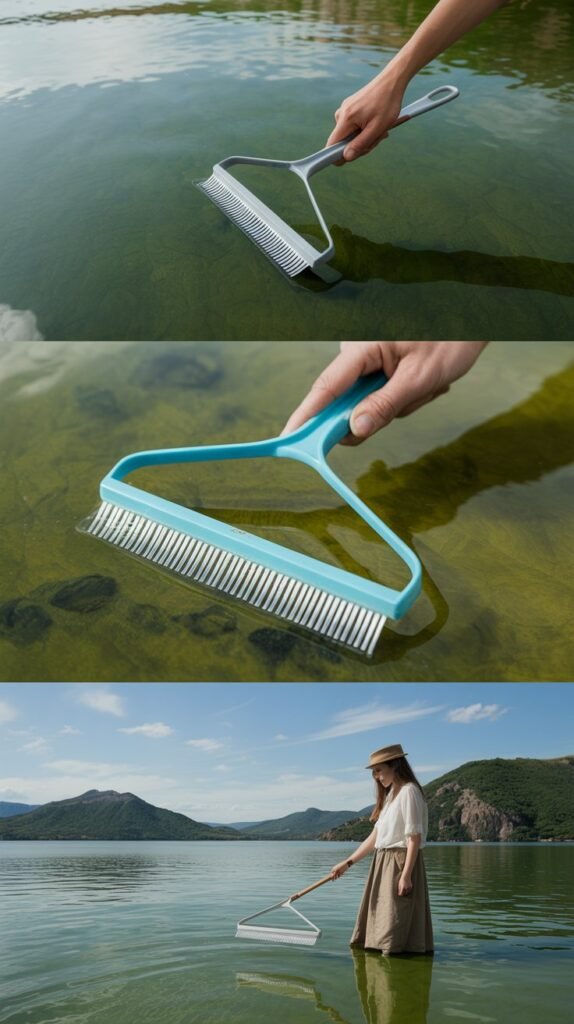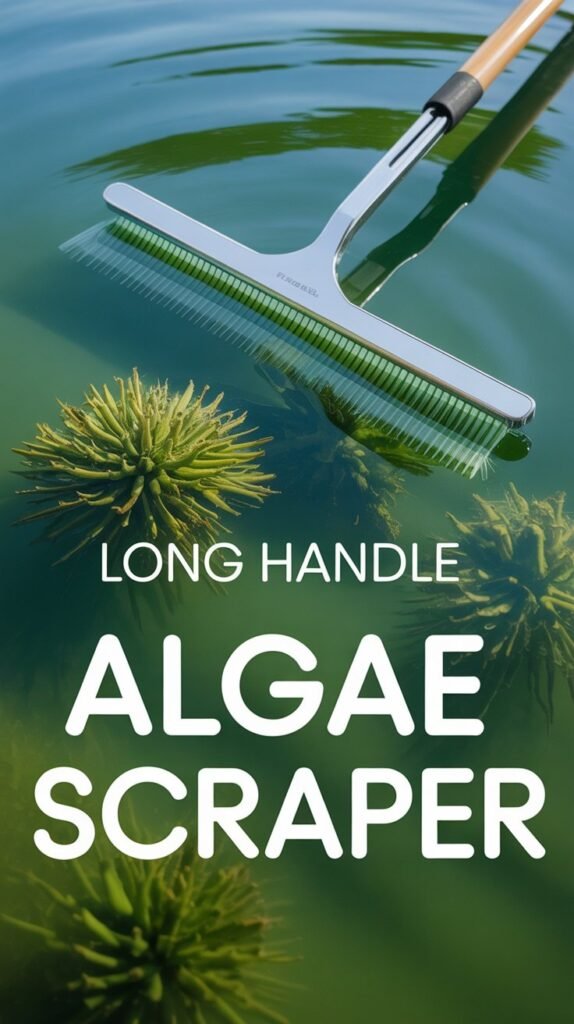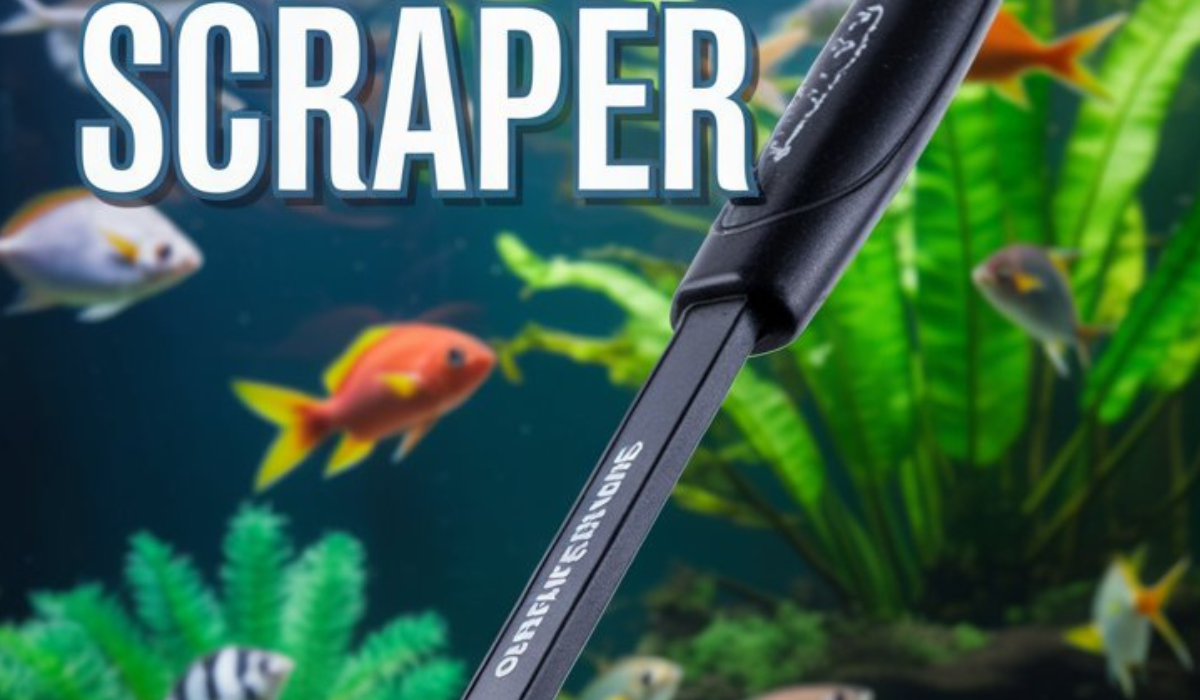Keeping your aquarium clean and free of algae is one of the most important parts of fishkeeping. Over time, algae can grow on your tank glass, decorations, and even your plants. It not only makes your aquarium look unattractive but can also affect water quality and light penetration. That’s where a long handle algae scraper becomes a must-have tool for every aquarist.
Whether you have a freshwater or saltwater aquarium, a long handle algae scraper helps you clean hard-to-reach spots easily—without getting your hands wet or disturbing your fish. In this comprehensive guide, we’ll cover everything you need to know about long handle algae scrapers: what they are, their benefits, how to use them effectively, and tips for maintaining a spotless aquarium.
What Is a Long Handle Algae Scraper?
A long handle algae scraper is a specialized aquarium cleaning tool designed to remove algae buildup from the glass or acrylic walls of your tank. It consists of a long handle with a scraping head at the end, which may have a metal blade, plastic edge, or sponge pad depending on the model.
This tool allows aquarists to clean tall or deep tanks without submerging their hands into the water. The design provides greater reach, control, and comfort, making aquarium maintenance faster and easier.
Why Algae Grows in Aquariums

Before diving into the details of the scraper, it’s important to understand why algae appears in your aquarium. Algae growth is a natural part of any aquatic ecosystem, but it can get out of control due to:
- Excess light exposure – Too much or prolonged lighting promotes algae growth.
- High nutrient levels – Nitrates and phosphates from fish waste and uneaten food feed algae.
- Overfeeding fish – Uneaten food breaks down, releasing nutrients for algae to thrive.
- Infrequent water changes – Waste and debris accumulate over time.
- Lack of live plants – Plants compete with algae for nutrients; without them, algae grows faster.
Regular cleaning with a long handle algae scraper helps manage algae before it becomes a serious issue.
Why You Need a Long Handle Algae Scraper
A clean aquarium isn’t just about looks—it’s about maintaining a healthy and balanced environment for your fish. Here’s why a long handle algae scraper is such a valuable tool:
1. Keeps Aquarium Glass Spotless
Algae buildup can make your glass hazy and reduce visibility. A scraper effectively removes even stubborn algae from the walls, keeping your view crystal clear.
2. Protects Your Fish’s Health
Algae can affect oxygen levels and light penetration in your tank. Regular cleaning ensures better water quality and a healthier ecosystem.
3. Prevents Hand Contamination
Placing your hands in the tank can introduce oils, soaps, or bacteria. A long handle keeps your hands dry and your fish safe.
4. Reaches Hard-to-Access Areas
Tanks that are deep or large can be difficult to clean by hand. The long handle lets you reach the bottom or back corners easily.
5. Reduces Stress for Fish
Fish often get scared when hands or large tools enter the tank. A scraper allows quiet and gentle cleaning without disturbing them.
6. Saves Time and Effort
Instead of scrubbing the tank manually, a scraper makes the process quick, efficient, and hassle-free.
Types of Long Handle Algae Scrapers

Not all scrapers are the same—different types are designed for various aquarium needs. Let’s look at the most common ones.
1. Blade Scrapers
These have metal or plastic blades attached to the head.
- Metal blades: Best for glass aquariums; they remove tough green spot algae easily.
- Plastic blades: Safe for acrylic tanks, as they won’t cause scratches.
Pros:
- Removes hard algae effectively.
- Provides a clean, streak-free finish.
Cons:
- Metal blades can scratch acrylic tanks.
- Blades need replacement after wear.
2. Sponge or Pad Scrapers
These use abrasive pads or sponges instead of blades. They are gentle and safe for all tank types.
Pros:
- Great for general cleaning and soft algae.
- Safe for acrylic and glass tanks.
Cons:
- Not effective for hard or thick algae.
3. Magnetic Algae Scrapers
These come in two parts: one inside the tank and one outside. You move the outer part to control the inner scrubber magnetically.
Pros:
- No need to insert a scraper into the tank.
- Great for daily cleaning.
Cons:
- Can trap sand or gravel, which may scratch glass.
- Less effective on stubborn algae.
4. Multi-Tool Scrapers
Some models combine multiple tools in one handle—blade, pad, and gravel rake attachments.
Pros:
- Versatile and space-saving.
- Great for deep tanks.
Cons:
- Usually more expensive.
Choosing the Right Long Handle Algae Scraper
Here are a few important factors to consider before buying:
1. Tank Type
- Glass tank: Go for a stainless steel or metal blade scraper.
- Acrylic tank: Choose a plastic or sponge scraper to prevent scratches.
2. Handle Length
Select a handle long enough to reach every corner of your tank comfortably. Common lengths range from 18 to 36 inches.
3. Blade Type
Opt for replaceable blades if you have persistent algae. Adjustable-angle blades are ideal for curved glass tanks.
4. Durability
Choose a scraper made from corrosion-resistant materials like stainless steel or reinforced plastic.
5. Comfort and Grip
A good handle should have an ergonomic design with a non-slip grip for better control during cleaning.
6. Water Depth
If you have a deep tank, a telescopic handle scraper is the best choice—it allows you to adjust the length as needed.
How to Use a Long Handle Algae Scraper

Using a long handle algae scraper properly ensures effective cleaning and prevents accidental damage to your aquarium.
Step 1: Prepare Your Aquarium
Turn off your aquarium equipment like filters or heaters to prevent splashing or interference during cleaning.
Step 2: Inspect the Scraper
Check the blade or sponge for any sharp edges, rust, or debris that could scratch the glass.
Step 3: Start from the Top
Insert the scraper and begin cleaning from the top of the tank, moving down in smooth, vertical strokes. This prevents loosened algae from settling on cleaned areas.
Step 4: Focus on Corners and Edges
Use the edge of the scraper to reach corners, decorations, and seams. Move gently to avoid damaging the silicone seals.
Step 5: Avoid Stirring the Substrate
When cleaning near the bottom, be careful not to dig into the gravel or sand. Debris can scratch the glass if caught under the blade.
Step 6: Rinse and Repeat
Remove the scraper occasionally to rinse off algae buildup, then continue until the glass is clear.
Maintenance Tips for Long Handle Algae Scrapers
Proper care extends the life of your scraper and ensures it performs effectively.
- Rinse After Every Use: Rinse the scraper in freshwater to remove salt, debris, and algae residue.
- Dry Properly: Allow it to dry completely before storing to prevent rust or bacterial growth.
- Replace Blades Regularly: Dull or rusty blades can scratch the glass. Replace them as soon as they show wear.
- Store Upright or Hung: Keep the scraper in a dry, vertical position to protect the blade or pad.
- Avoid Harsh Chemicals: Never use soap or detergents to clean your scraper, as residues can harm your fish.
Safety Tips When Using a Long Handle Algae Scraper
- Always use the right blade for your tank type (metal for glass, plastic for acrylic).
- Do not apply excessive pressure while scraping; gentle strokes are more effective and safer.
- Keep your scraper away from children and pets.
- If you have magnetic scrapers, ensure there’s no gravel stuck to the inner magnet before use.
Benefits of Using a Long Handle Algae Scraper
- Efficient Cleaning: Quickly removes algae without disturbing your aquascape.
- Prevents Tank Contamination: Keeps your hands and foreign substances out of the water.
- Improves Light Penetration: Clear glass enhances light for plants and fish visibility.
- Saves Time: A long reach means less effort for thorough cleaning.
- Reduces Stress on Fish: Minimal hand movement keeps fish calm during cleaning.
- Enhances Tank Aesthetics: Keeps your aquarium looking new and vibrant.
Common Mistakes to Avoid
- Using wrong blade type: Metal blades on acrylic tanks cause scratches.
- Scraping too fast: Quick movements can startle fish or stir debris.
- Ignoring blade condition: A dull blade reduces effectiveness and may damage the glass.
- Skipping regular cleaning: Algae becomes harder to remove if left too long.
DIY Long Handle Algae Scraper Ideas
If you prefer a budget-friendly solution, you can make your own algae scraper at home.
1. Using a Plastic Rod and Razor Blade
Attach a razor blade securely to one end of a long plastic stick or old net handle using waterproof tape. Use only for glass tanks.
2. Sponge-on-a-Stick
Glue an aquarium-safe sponge to the end of a long handle. Great for general cleaning on acrylic tanks.
3. Magnetic DIY Cleaner
Attach strong magnets to both sides of the glass, one covered with a soft pad. Move the outer magnet to control the inner cleaner.
Tip: Always test DIY tools on a small, hidden area first to ensure they don’t scratch the glass.
How to Prevent Algae Growth
Even with a scraper, it’s best to control algae before it becomes a problem.
- Regulate Lighting: Keep aquarium lights on for only 8–10 hours daily.
- Avoid Overfeeding: Feed only what your fish can eat in 2–3 minutes.
- Regular Water Changes: Replace 20–30% of tank water weekly.
- Maintain Filtration: Clean your filter media regularly to prevent nutrient buildup.
- Add Live Plants: They compete with algae for nutrients.
- Control Nutrients: Use quality fish food and test your water for nitrates and phosphates.
How Often Should You Use an Algae Scraper?
For most aquariums, cleaning once a week is enough. However, if your tank receives a lot of sunlight or has heavy nutrient loads, you might need to scrape every 3–4 days.
Regular cleaning prevents algae from hardening, making the process easier and quicker.
Best Practices for a Clean and Healthy Aquarium
- Combine mechanical cleaning (scraper) with biological balance (live plants, snails).
- Always test your water parameters after cleaning to ensure stability.
- Clean decorations and rocks periodically to maintain overall clarity.
- Keep your aquarium covered to reduce airborne contaminants.
- Use a gravel vacuum during water changes to remove waste and uneaten food.
Conclusion
A long handle algae scraper is an essential tool for every aquarium enthusiast who values a clear, healthy, and beautiful tank. It simplifies maintenance, keeps your hands dry, and ensures your fish live in a clean environment.
Whether you’re maintaining a small home aquarium or a large display tank, investing in a high-quality scraper will make cleaning easier, faster, and more effective. With proper use, care, and a good cleaning routine, your aquarium will always remain a stunning centerpiece in your home.
FAQs About Long Handle Algae Scraper
1. Can I use a long handle algae scraper on an acrylic tank?
Yes, but use a scraper with a plastic or soft blade to prevent scratches. Avoid metal blades on acrylic surfaces.
2. How often should I clean my aquarium glass?
Clean your glass weekly or whenever you notice algae buildup. Regular maintenance prevents stubborn stains.
3. Do I need to remove my fish while scraping algae?
No, you can safely clean the glass with fish inside as long as you move slowly and avoid stressing them.
4. Are magnetic scrapers better than long handle scrapers?
Both are useful. Magnetic scrapers are great for daily light cleaning, while long handle scrapers are better for deep or stubborn algae.
5. Can I use household cleaning pads or sponges?
No, only use aquarium-safe materials. Household pads may contain chemicals harmful to fish.
6. How long does a scraper blade last?
It depends on usage, but typically you should replace blades every few months or when they become dull.
7. What should I do if I accidentally scratch my tank?
Minor scratches on glass can sometimes be buffed out using aquarium-safe polish. On acrylic tanks, use specialized scratch removal kits.
8. Is it safe to use a metal scraper in saltwater tanks?
Yes, as long as the scraper is made from stainless steel or corrosion-resistant materials. Rinse it after every use.
9. Can algae scrapers be used on decorations?
Yes, but gently. Avoid using sharp blades on fragile or painted decorations.
10. Do algae scrapers remove all types of algae?
They can remove most forms, including green spot and brown algae, but for hair algae or cyanobacteria, you may need additional treatments.
Final Thought:
A long handle algae scraper is your aquarium’s best defense against stubborn algae buildup. It keeps your glass spotless, your water clear, and your fish stress-free. Combine it with regular water changes, balanced feeding, and good lighting control, and you’ll enjoy a stunning, algae-free aquarium all year round.

